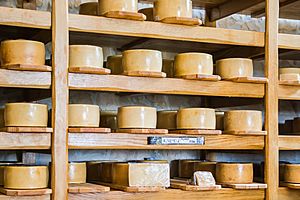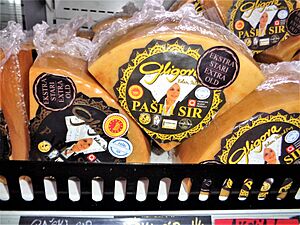Pag cheese facts for kids
Quick facts for kids Paški sir |
|
|---|---|
 |
|
| Country of origin | Croatia |
| Region | Northern Dalmatia |
| Source of milk | Sheep |
| Pasteurized | Frequently |
| Texture | Hard |
| Aging time | 2–18 months |
| Certification | Paški Sir PDO |
| Named after | Lua error in Module:Wikidata at line 70: attempt to index field 'wikibase' (a nil value). |
Pag cheese or Pag Island cheese (Croatian: Paški sir) is a special kind of hard sheep milk cheese from the Croatian island of Pag. It has a very unique and strong flavor. Many people believe it is the most famous handmade cheese from Croatia. You can even find it in many markets outside of Croatia.
A Look Back in Time
In 1774, a travel writer named Alberto Fortis visited the island of Pag. He wrote about the cool things the island produced. These included sea salt, honey from sage plants, wool, and Pag cheese.
Until the early 1900s, people on Pag had their own small stone huts. They used these huts to milk their sheep and make Pag cheese. These stone huts were built on the rocky hills above the pastures. They were often decorated with sedge and reeds from nearby fields. The island's pastures are mostly on hilly parts. You can spot them by the dry stone walls that surround them. From far away, these walls look like the famous Pag lace because of their detailed patterns. In the past, no one owned the pastures. Sheep could graze freely anywhere on the land.
Over time, the pastures slowly became privately owned. So, the shepherds moved back into the towns. Their stone huts became homes for their pastures. Shepherds would travel to and from the pastures to care for their sheep. This meant that the women often took on the job of making cheese. Pag cheese slowly became more important. It was not just food for the locals. It also became a product to sell across Croatia. This made Pag cheese a key way for villagers to earn money.
How Pag Cheese Is Made
The island of Pag has a long history of making cheese and farming. It is the most indented island in the Adriatic Sea. This shape helps create perfect conditions for making cheese. The eastern side of Pag Island is next to the Velebit mountain range on the mainland.
On these snowy mountain peaks, hot and cold air mix. Especially in winter, this creates the Pag Bora wind. The Bora is a strong, cool, and dry wind. It gains strength as it rushes down the southern slopes of Velebit. Then it blows over the calm seas. The Bora wind dries out and turns into fine salt dust. It then scatters this salt dust all over Pag, making it a white, salty island.
When this salt dust falls on plants, it makes them wet. In these tough conditions on Pag's rocky hills, only very strong and fragrant plants can survive. The most famous and valuable plant is the fragrant Pag's Sage. There are many groups of this purple-flowered plant. They decorate the pure white limestone in May and fill the air with their scent.
Pag's own special breed of sheep graze freely on this salty and fragrant vegetation. This gives their milk unique qualities and taste. This special taste then goes into the Pag cheese, making it truly one-of-a-kind.
Protecting Pag Cheese
The main makers of Pag cheese joined together to form an association. Their goal was to get a special label for Pag cheese. This label is called "Protected Designation of Origin" (PDO). The European Commission officially gave this label on November 25, 2019.
The PDO label means there are strict rules for how Pag cheese is made. It also means the ingredients must come from a specific place. This helps make sure that Pag cheese will always be a product truly from Pag Island.


